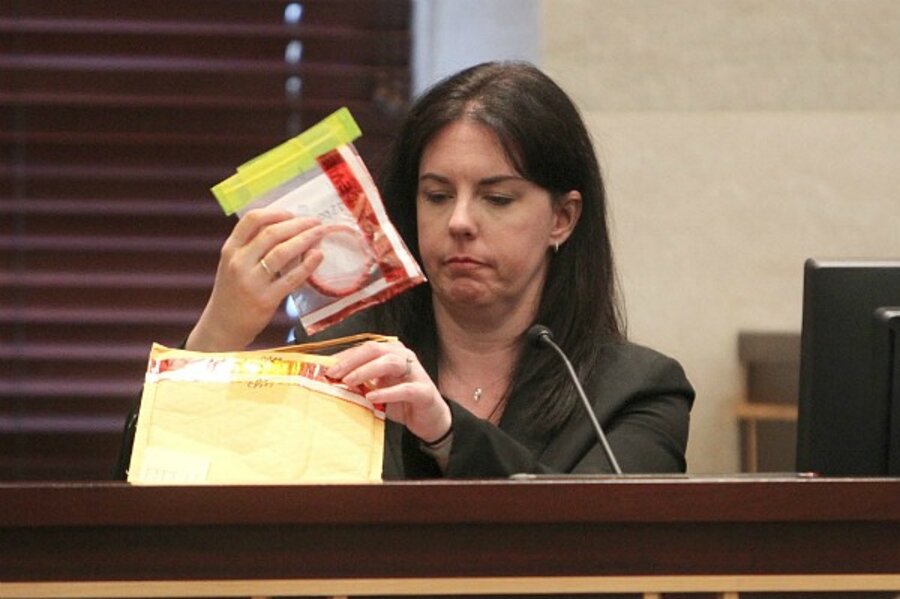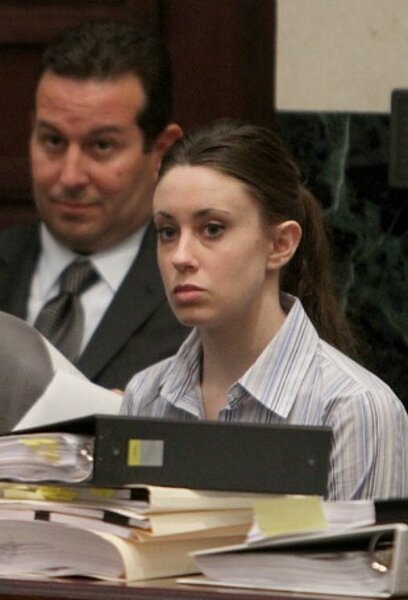Casey Anthony case resembles real-life CSI crime drama
Loading...
As it enters its third week of testimony, the trial of a young Florida woman accused of killing her two-year-old daughter is beginning to resemble a real-life version of the popular television crime drama "CSI."
Prosecutors in the Orlando trial have succeeded in proving that Casey Anthony repeatedly lied to her friends, to her family, and to the police in the weeks following the disappearance of her daughter, Caylee, in the summer of 2008.
But the state attorney’s office has yet to introduce any direct evidence that Ms. Anthony physically harmed the toddler.
Instead, prosecutors are seeking to build a circumstantial case. At the center of the effort are two key pieces of forensic evidence – a 9-inch strand of hair found in the trunk of Anthony’s car and a strong, lingering odor in the car that prosecutors say is the stench of death.
Anthony’s lawyer, Jose Baez, has attacked the state’s reliance on the forensic evidence, saying prosecutors are using “junk” science to try to win a conviction.
It is unclear how individual jurors will weigh the nuances of such forensic evidence. Given the lack of other physical evidence in the case, it could emerge as a turning point for either side.
This week, prosecutors are expected to call to the stand a research scientist, Dr. Arpad Vass of the Oak Ridge National Laboratory in Tennessee, who is working to develop a signature for the smell of a decomposing human body.
His work could be a major benefit to investigators because it would enable them to know that a dead body had been in a certain location by detecting a lingering “odor signature” long after the body had been removed.
Science not yet proven reliable
The science is emerging. Critics say it is not yet peer-tested and proven reliable enough for use in a criminal trial, let alone a first-degree murder trial carrying a potential death sentence.
The Anthony trial will be the first time Dr. Vass’s research is presented to a jury in a trial.
Dr. Vass examined air samples taken from the trunk of Anthony’s car. According to court documents, he identified an odor signature in the car that was consistent with the early stages of human decomposition. But because of the current limits of the science, he is unable to say with absolute certainty that a dead body was in the trunk of the car.
On Saturday an FBI forensic expert testified that a 9-inch strand of hair found in the car trunk showed signs that it might have come from the head of a decomposing body.
The expert, Karen Lowe, also told jurors that based on her microscopic analysis the strand of hair was consistent with hair found in a brush used by Caylee.
Prosecutors are trying to convince the jury that Anthony killed her daughter, Caylee, and then placed the body in the trunk of her car. Like the odor evidence, the hair evidence is important because it would help link the mother to the dead child through the body’s suspected presence in the car trunk.
FBI expert acknowledges limitations
But the FBI expert’s testimony came with acknowledged limitations. Ms. Lowe conceded that she could not testify with measurable scientific certainty that the hair came from a dead body, and, more important, that it came from Caylee’s dead body.
Here is what the FBI expert said on cross examination about the limits of her findings: “At the end of the day I can’t say absolutely that hair came from Caylee Anthony.”
Defense Attorney Baez sought to further undermine Lowe’s testimony by citing a 2009 National Academy of Sciences report on the reliability of forensic science in the courtroom.
The report was particularly critical of the use of microscopic hair analysis, noting that some judges had found its use “highly unreliable.”
The 2009 report says in part: “… Microscopic studies alone are of limited probative value. The committee found no scientific support for the use of hair comparisons for individualization in the absence of nuclear DNA [tests].”
Lowe said such DNA testing was not possible and that her testimony was based on a microscopic comparison of the two hair strands.
Ultimately it will be up to the jury to assess the importance and reliability of the forensic evidence and the science used to analyze it.
Concern about the "CSI effect" on jurors
Some legal analysts have expressed concern about a so-called “CSI effect” on jurors in criminal trials.
The popularity of television dramas like "CSI," featuring forensic investigators who are able week after week to solve difficult crimes with scientific certainty, may create unreasonable expectations in the minds of jurors, making it more difficult for prosecutors to win convictions.
Other analysts suggest the CSI effect could cut the other way, making jurors more likely to accept and credit forensic evidence during their deliberations.
Anthony, 25, is charged with first degree murder. If convicted she faces a possible death sentence. She is also charged with aggravated child abuse, aggravated manslaughter of a child, and four counts of providing false information to a law enforcement officer.
Six months after her disappearance, Caylee’s remains were discovered in a wooded area a short walk from the family home. Prosecutors say three strips of duct tape had been wrapped around the child’s mouth and nose.
Defense lawyers maintain that Caylee drowned accidentally in the backyard pool and that Anthony and her father, George, participated in a cover up to make it look like a kidnapping and murder.
George Anthony has denied any wrongdoing and any involvement in a cover up.






